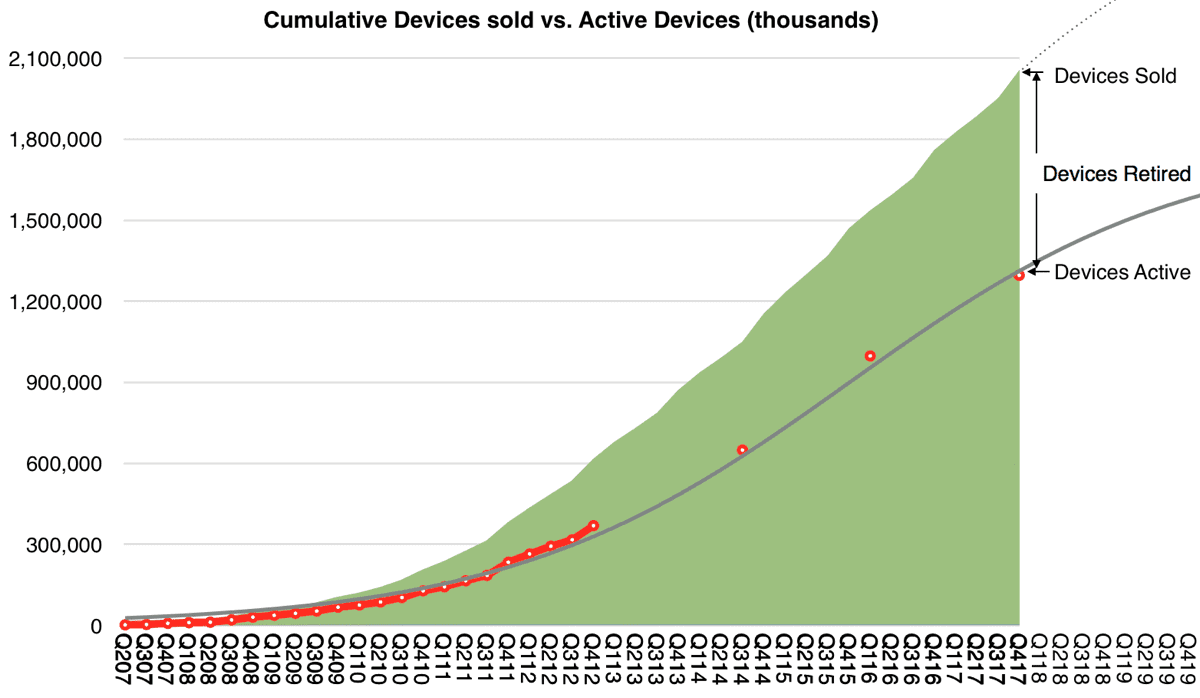Two out of three Apple devices ever sold are still in use, according to Asymco. Horace Dediu arrived at this number by taking the total number of monthly active devices and comparing it to the total number of devices sold. But it’s not just about the number of devices, it’s also about customer satisfaction.
The Number
Dr. Edward Deming, a statistician, said that “the numbers that best define a company are…the value of a satisfied customer and the value of a dissatisfied customer.” And these numbers difficult to quantify.
Apple sends out satisfaction surveys to customers and that is what the company measures . But Horace points out that people tend to lie and say things that they judge the listener will want to hear, in an effort to be liked more.

So to get around that, he created a formula to chart Apple devices: S÷(1+EXP(−1×(t−o)÷g)) where S is the point of saturation or maximum population size, t is the period or count of quarters (1 for Q1 2007 and 2 for Q2 2007, etc), o is the offset to 50% or the point of inflection, in quarters, and g is the growth factor. The S-curve in the chart corresponds to S=1.8 billion, o=35 and g=8.
Once you have an estimate of the active device (user) base size, you can use to to predict units sold and revenue. The conclusion is the ratio between cumulative units and active units, which gives us the number 64%. This is the percentage behind the “2 out of 3 Apple devices sold are still in use” rule of thumb.
This is the number you use to predict Apple’s business. It’s a better satisfaction measurement than surveys, because raw data doesn’t lie. And presumably you can chart this into the future to make predictions, which is what good science is about.

I still use an iPad 1st Gen 32GB as a music player and alarm clock.
Being on iOS 5.1.1, it doesn’t handle websurfing at all well in the modern age, but for what I need, it’s still “a really useful engine”.
https://www.youtube.com/watch?v=dVmLTApnwag
And I still use a iPod touch 3rd Gen 64GB as a music player, connected by BT to some in ear headphones that “drown out” the noise of the ride on mower.
I still use an iPhone 5 as my mobile phone, and an iPad mini 4 as my main devices.
A. What it the bottom axis measuring? Quantity?
What is the time frame?
B. “ever sold”
So 2/3s of the original Macintosh are still in use?
I find that hard to believe.
C. And how does the “use” (or dis-use) of significantly older machines relate to “satisfaction” in the present.
(I still own, but don’t use, my 512K Mac. Although I did use it into the 2000s…..and had it plugged in for several years after I stopped using it.)
(Was I satisfied by that product? Yes. But does my non-use of it now does reflect dis-satisfaction with it? It’s a seriously obsoleted machine.)
There is a lot of “hue-eee” in this article. This statistic is not all that probative.
And then there is the sentence “A liked product will be used and a well-liked product will be used more.”
At first glance, that seems like acceptable common sense. But it does really work that way. That sentence doesn’t translate into any valid scientific measurement.
Maybe I like my iPhone 6 Plus better than my iPhone 5. But when I owned the iPhone 5 I used it 100% of the time. And when I own the iPhone 6 Plus I used it 100% of the time. I wasn’t able to use one phone MORE than the other.
I do think it might be slightly misleading. For example, I think it’s only true because the number of sales grows exponentially. Recent sales (which are likely to still be active) account for a big part of total sales. Around 70% of total sales as of Q4 2017 happened within the last 5 years.
Also, I may have a lot of issues (problems and unhappiness), not with the hardware itself, but with its OS or its Apple sw programs.
I “use” the device, but chaff at how it operates.
“Using” (having it active) a device and being 100% happy with it’s hardware, operating system, and software programs are two different things altogether.
I might use a device, but not be happy/satisfied with it, or certain aspects of it.
Because I already own it, and paid for it, I might continue to use it for a very long time.
I might have it turned on, but use another device more frequently.
So I don’t consider devices to be in “use” (active) to be that much of a significant measurement at all.
It’s interesting. It does mean something, especially in comparison with other products and brands. But it is not necessarily a good gauge of satisfaction at all.